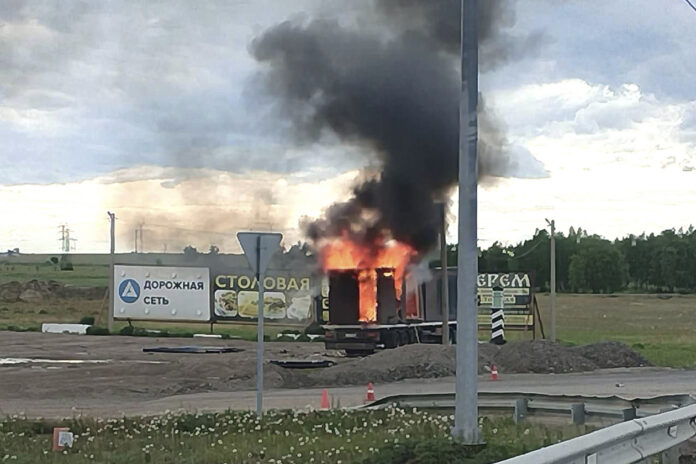The extraordinary drone attacks on Russian airfields by Ukraine have prompted politicians and military officials from both parties to demand for the immediate fix of serious security flaws at American air bases.
In a bold action that destroyed five military sites and damaged over 40 aircraft, Kyiv deployed over 100 drones inside Russia this week using artificial intelligence. Video showing Russian fighters and bombers engulfed in flames while parked on public tarmacs quickly went viral online and in Washington.
The strikes revealed how readily and inexpensively unmanned systems might cripple sophisticated air forces, but they did deal a major blow to a U.S. ally. The United States is trying to increase its military presence in the Pacific, which is causing officials a great deal of worry. The rapid devastation of airpower by enemy drones was demonstrated by Ukraine’s triumph.
Sen. John Boozman (R-Ark.), who chairs the Appropriations subcommittee on Military Construction and Veterans Affairs, stated in an interview that the situation should make people more conscious of the nation’s vulnerability. “The Ukrainians were able to defeat the Russian navy without possessing any ships, and now they are facing a similar challenge with their air force, which they have severely underequipped.”
American planes are especially at risk, according to lawmakers and military experts, since they fly unprotected in the open. American defense expenditure objectives and strategies, such as the purchase of more counter-drone technology, reinforced aircraft shelters, or camouflage, may need to be reevaluated in light of the strike.
General David Allvin, chief of staff of the Air Force, referred to the Ukrainian attack as a “wake-up moment” and hinted that it will influence the ongoing discussions in Washington on military budgets. At an event hosted by the Center for a New American Security on Tuesday, he made the statement, “Seemingly impenetrable locations, maybe, are not,” while also mentioning that the $7 billion in damage was surprising. “That is something that requires our full focus.”
A statement from the Air Force stated that its personnel are prepared to defend against many threats, including swarms of drones. In addition to investing in “layered air and missile defense technologies, early warning systems, and rapid response protocols designed to detect, track and neutralize airborne threats,” the statement said that the military is building capabilities to ward against future threats.
During a news conference on Tuesday, White House spokeswoman Karoline Leavitt informed reporters that President Donald Trump is cognizant of the military’s vulnerabilities and is actively working to address them.
This type of threat was considered when the plans for the enormous Golden Dome missile shield were first announced, she added. As far as the future of warfare is concerned, Trump “has a full understanding… about how drones are a big part of that.”
According to Leavitt, this is one of the reasons why Trump is seeking the passage of the Republicans’ tax and spending proposal, which would provide $150 billion to the Pentagon.
As Congress considers that megabill, the problem may have repercussions. The bill allocates more funds for counter-drone defenses, as pointed out by Roger Wicker (R-MS), Senate Armed Services Chair, in response to the unprecedented need for such capabilities.
According to him, the military had already taken into account the possibility of drone attacks on grounded aircraft before to the Ukrainian strike. However, the public may pay more heed to the episode’s warnings about inexpensive, unmanned technology.
“There’s no doubt that we have a myriad of aircraft… stored in facilities, really, that are designed to protect them from the weather and are not resistant to explosives like the ones the Ukrainians used,” Wicker said Wednesday at a Defense Writers Group event with reporters. Everyone needs to take this as a wake-up call. Our military planners probably aren’t too surprised by it.
The situation is particularly worrying in the Pacific, where American bases are located near China’s expanding missile arsenal. Over the last ten years, China has constructed over 400 hardened aircraft shelters, which are concrete bunkers that defend jets from missile and drone strikes, according to a study by Thomas Shugart and Timothy Walton of the Hudson Institute. The United States has only added 22 to the region.
“Large numbers of American bombers sit open on the tarmac, just like the ones we saw in those videos,” claimed Shugart, a retired Navy officer.”It seems like things aren’t taking the necessary steps to ensure this.”
There is concern about going outside party boundaries. This drone assault demonstrates that Ukraine is “really in this fight” and confirms a “pressing concern” that the United States lacks sufficient counter-drone capabilities both domestically and abroad, according to Senator Chris Coons (D-Del.), the leading Democrat on the Senate Defense Appropriations subcommittee.
According to Coons, “I have been raising this and pressing this in every meeting with every senior military leader, speed up procurement, speed up deployment.” CONS made these remarks during an interview. “Most places in the world, this proves that we are really vulnerable to assaults by advanced drones.”
Because of the large military presence in the state, Virginia is paying close attention to the attack.
A senior member of the Senate Armed Services Committee, Senator Tim Kaine (D-Va.), characterized the strikes as a “example in battlefield innovation” that ought to cause a reassessment of the security of American sites.
He emphasized the importance of taking significant measures to safeguard domestic infrastructure. Neither the policies nor the means to put them into action have been fully determined, in my opinion.
Sen. Mark Warner, a fellow Virginian and the senior Democrat on the Senate Intelligence Committee, said that a national security expert had shown him satellite photos of American sites showing exposed U.S. military planes following the strike in Ukraine.
Redefining warfare, he declared, were the Ukrainians. “We must draw lessons from this.”
